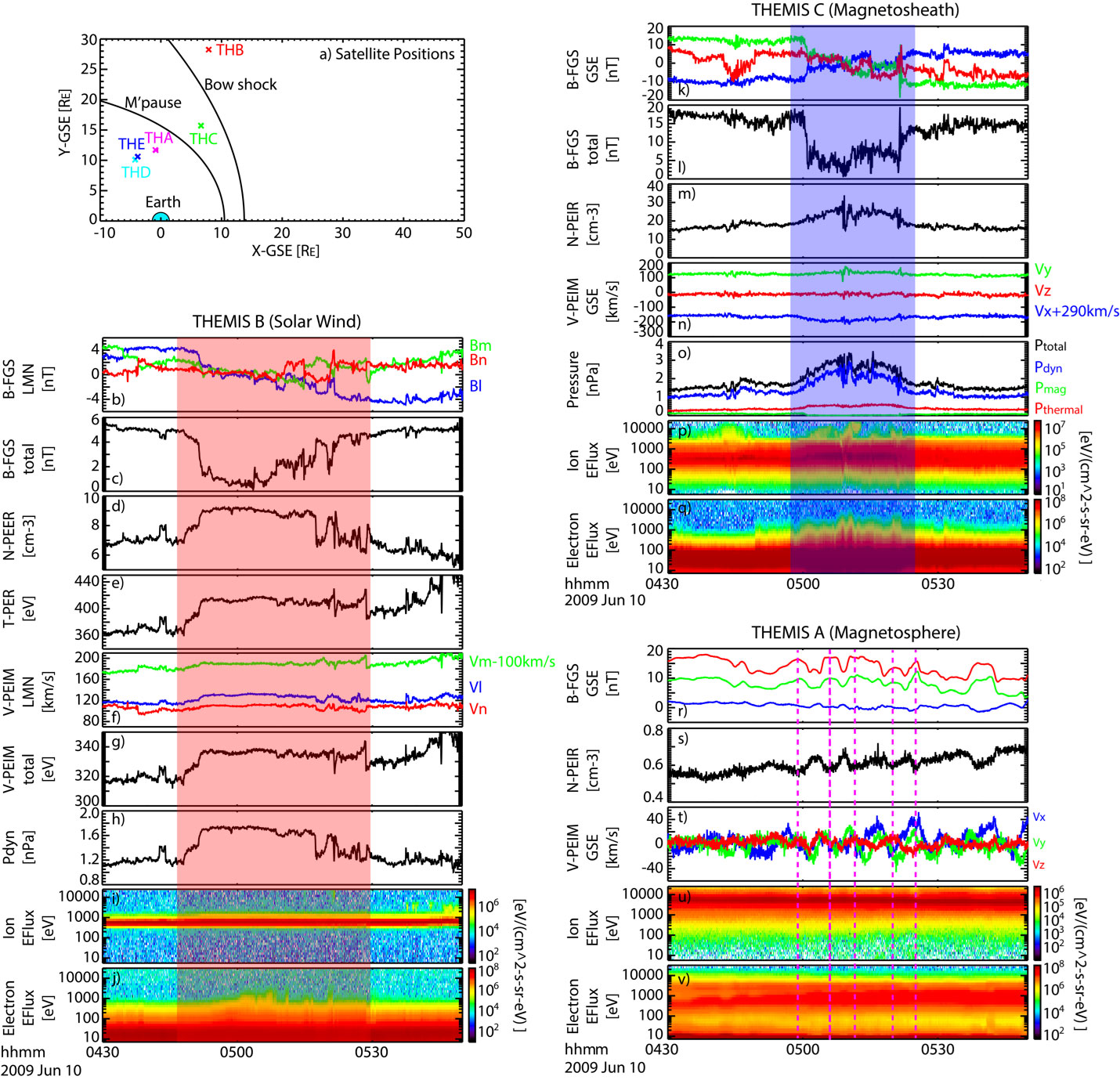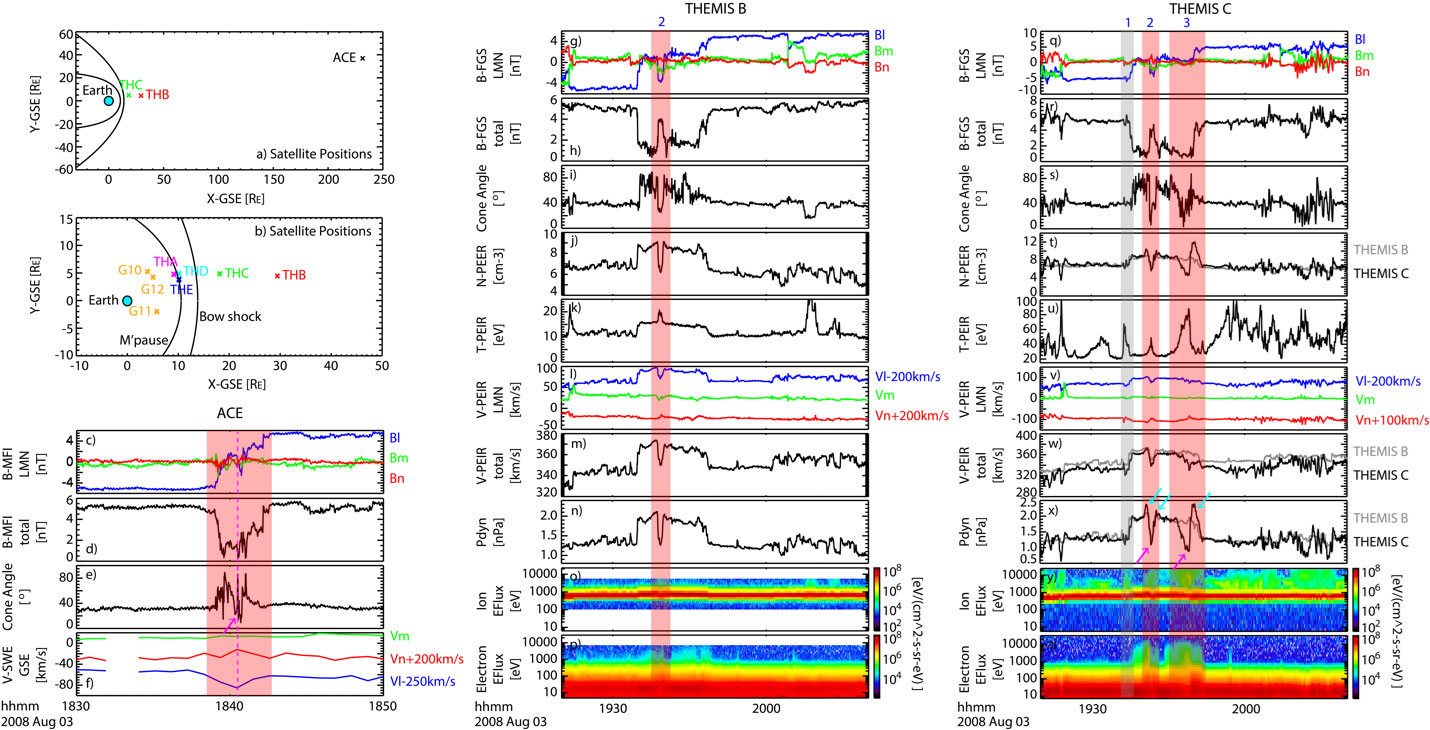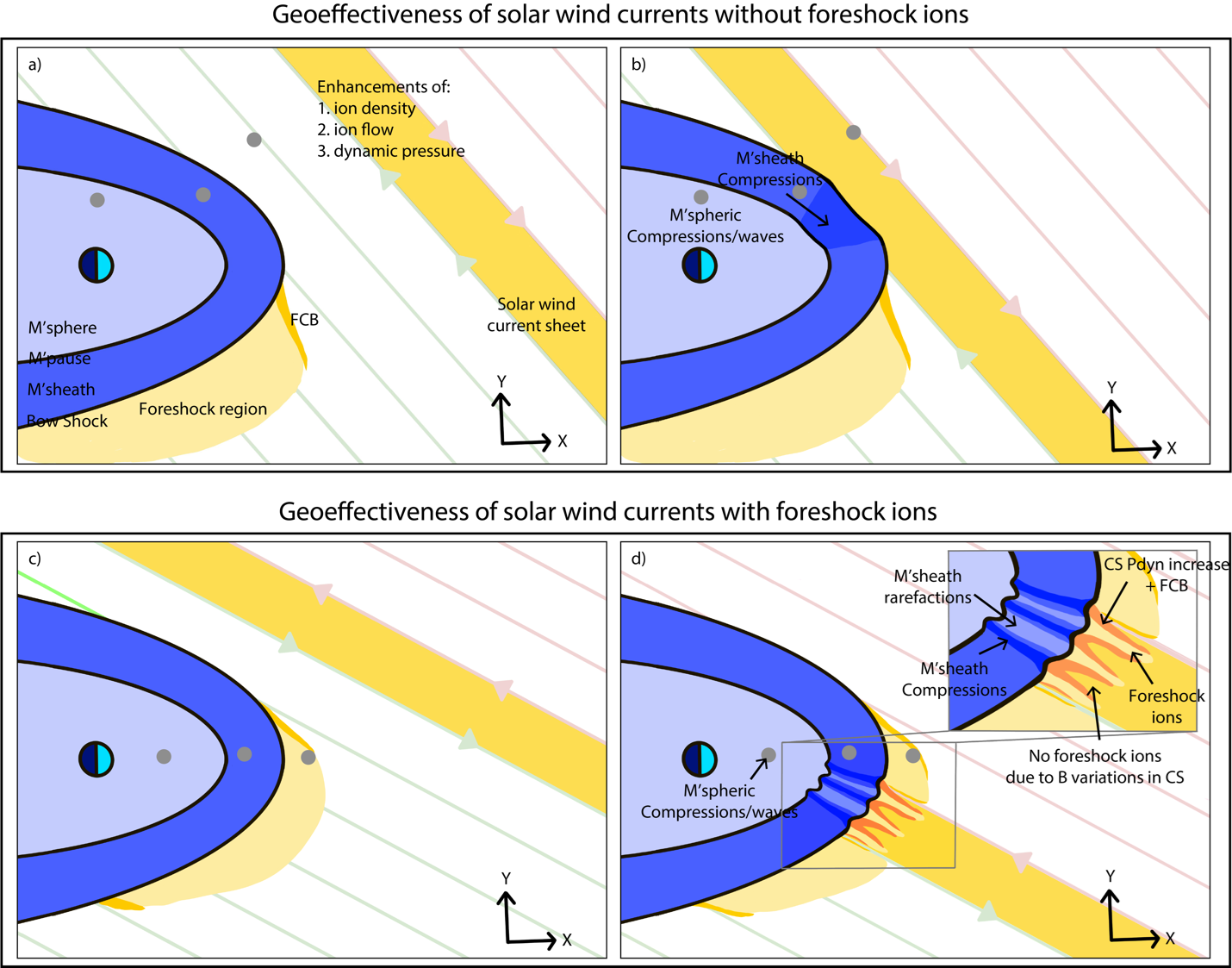
2022 THEMIS SCIENCE NUGGETS
The geoeffectiveness of solar wind current sheets and its modulation by foreshock ions
by Boyi Wang
Institute of Space Science and Applied Technology, Harbin Institute of Technology, Shenzhen
Introduction
Many solar wind current sheets have bifurcated structures with two current density peaks separated by a current depression region at the sheet center, which behave as two sharp magnetic field changes with weak nearly uniform magnetic fields in between. They frequently occur in the solar wind, magnetopause and magnetotails. The bifurcated current sheet (BCS) model and the previous in situ observations show that bifurcated current sheets are associated with plateaus in plasma density, which are corresponding to plateaus in dynamic pressures. The dynamic pressure enhancements generated by solar wind bifurcated current sheets potentially compress the Earth’s magnetosphere and cause further disturbances in the coupled magnetospheric and ionospheric system. On the other hand, the magnetic field variations in the current sheet structures can change the shock condition of the Earth’s bow shock from quasi– parallel to quasi– perpendicular, preventing the generation of foreshock ions inside the current sheets, or vice versa. They likely cause current sheets to be more fluctuating, with rarefactions and compressions occurring within these thin current sheets. These could potentially cause magnetosheath perturbations, magnetopause fluctuations and increase the current sheets’ geoeffectiveness. However, although solar wind bifurcated current sheets are reported to trigger magnetic reconnections in the magnetosheath and likely cause magnetopause reconnections when they are associated with guide fields in southward directions or IMF southward turnings, there were no studies investigating their evolutions in the foreshock and magnetosheath in terms of the dynamic pressure modulations and the corresponding further effects in the magnetosphere.
Results
In this study, we analyzed the evolutions of solar wind bifurcated current sheets associated plateaus in dynamic pressures, without (27 events) and with (7 events) foreshock-ion modulations, respectively, in the magnetosheath, based on the observations by THEMIS satellites in 2008 and 2009. We also investigated their effects on the magnetosphere, based on the observations by the THEMIS probes and the GOES satellites. Two examples are shown as below.
| Figure 1. The evolution of a current sheet without foreshock ions. Panel a shows the positions of THEMIS A (magenta), B (red), C (green), D (cyan) and E (blue) in the Geocentric solar ecliptic (GSE) coordinate at about 5:00 UT on June 10, 2009. Here, the positions of bow shock and magnetopause are obtained from the models in the previous papers. Panels b-j show b) magnetic field in the LMN coordinate, c) total magnetic field, d) electron density, e) ion temperature, f) ion velocity in the LMN coordinate, g) ion total speed, h) dynamic pressure, i) ion energy fluxes and j) electron energy fluxes, respectively, that were observed by THEMIS B in the solar wind. Panels k-q show k) magnetic field, l) total magnetic field, m) ion density, n) ion velocity in the GSE coordinate, o) total pressure (black), dynamic pressure (blue), magnetic pressure (green) and thermal pressure (red), p) ion energy fluxes and q) electron energy fluxes, respectively, that were observed by THEMIS C in the magnetosheath. Panels r-v show r) magnetic field, s) ion density, t) ion velocity in the GSE coordinate, u) ion energy fluxes and v) electron energy fluxes, respectively, observed by THEMIS A in the magnetosphere. |
The first solar wind bifurcated current sheet was observed by THEMIS B from 04:51:20 to 05:22:00 UT (highlighted by the red shade in Figure 1) on June 10, 2009. The total magnetic field inside this structure decreased by 98.9% from the background (Figure 1c). The density increased (Figure 1d) with ion flow increasing concurrently (Figure 1h), which further contributed to a dynamic pressure plateau of about 1.7 nPa. The IMFs in both downstream and upstream regions of the current sheet were about parallel to the bow shock in the postnoon sector, as illustrated in Figure 3a, which prevented the occurrence of foreshock ions. On the other hand, although THEMIS B was close enough to the bow shock, there were nearly no foreshock ions observed within the current sheet (Figure 1h). These indicate that this current sheet was not modified by the foreshock perturbations. Thus, the dynamic pressure plateau maintained for about 26 minutes with nearly no fluctuations. The magnetic field reversal of this solar wind current sheet remained in the magnetosheath (Figure 1j), as observed by THEMIS C. There was a dynamic pressure increase of about 1.7 nPa and a total pressure increase of 1.8 nPa in the magnetosheath (Figure 1o), which possibly triggered the magnetospheric waves that were observed by THEMIS A (Figures 1r-1t).
| Figure 2. Panel a shows the positions of ACE (black), THEMIS B (red) and THEMIS C, respectively, at about 19:40 UT on Aug. 03, 2008. Panel b shows the positions of THEMIS A (magenta), B (red), C (green), D (cyan), E (blue) and GOES satellites (orange), respectively, at about 19:40 UT on Aug. 03, 2008. Panels c-f show c) magnetic field in the LMN coordinate, d) total magnetic field, e) magnetic field cone angle in the GSE coordinate and f) ion velocity in the LMN coordinate, respectively, that were observed by ACE in the solar wind. Panels g-p show g) magnetic field in the LMN coordinate, h) total magnetic field, i) magnetic field cone angle in the GSE coordinate, j) electron density, k) ion temperature, l) ion velocity in the LMN coordinate, m) ion total speed, n) dynamic pressure, o) ion energy fluxes and p) electron energy fluxes, respectively, that were observed by THEMIS B in the solar wind. Panels q-z show the same format of Panels g-p, except that these were observed by THEMIS C. |
Another bifurcated current sheet was originally observed by the Advanced Composition Explorer (ACE) satellite from 18:39:00 UT to 18:42:30 UT at the L1 point on August 3, 2008. This bifurcated current sheet propagated towards the Earth and was observed from 19:34:50 UT to 19:49:00 UT by THEMIS B near the Earth’s bow shock. Figure 2n shows that concurrent enhancements of ion density and ion flow resulted in a dynamic pressure increase of about 1.1 nPa in this current sheet. The dynamic pressure increase was in an overall shape of a plateau, similar to the first event. When this current sheet moved closer to the bow shock, there were more foreshock ions observed by THEMIS C, which was even closer to the Earth’s bow shock than THEMIS B. Due to the cone angle being less than 45° in the downstream and upstream sides of the current sheet, foreshock ions were observed in these regions. The large cone angles within the current sheet structure overall prevented the occurrence of foreshock ions and caused significant perturbations. The illustration of this modulation is shown in Figure 3d. It is noted that the dynamic pressure enhancements within the current sheet were the total effects of the original dynamic pressure plateau inside the current sheet and the newly formed compressed boundaries of foreshock ions, which should be stronger than either of these two. We also track the evolution of this current sheet in the magnetosheath and in the magnetosphere (not shown here, but the details can be found in our paper). There were concurrent significant increases of plasma density, ion flow speed in sunward direction in the magnetosheath and significant compressional waves in the magnetosphere.
Conclusion
| Figure 3. The illustration of the geoeffectiveness of solar wind current sheets with and without foreshock ion modulations. The grey dots are rough locations of in-situ observations in this study. The pink and light green lines are IMF, and the arrows on them showing the directions of IMF. |
1. All of our events show that the plasma density enhancements in the solar wind bifurcated current sheets created a dynamic pressure plateau in the solar wind;
2. The solar wind bifurcated current sheets without any modulation of foreshock ions, as illustrated in Figures 3a and 3b, caused dynamic pressure plateaus in the magnetosheath and waves in the magnetosphere.
3. The solar wind bifurcated current sheets with modulations of foreshock ions, as illustrated in Figures 3c and 3d, caused significant dynamic pressure variations embedded in the dynamic pressure plateaus, which is attributed to inflated regions with superthermal ions and the corresponding compressional boundaries.
In summary, the dynamic pressure enhancements that are generated by the solar wind bifurcated current sheets are geoeffective. The foreshock ion modulations, which are expected to occur frequently inside the current sheets due to their magnetic field variations, can magnify that geoeffectiveness by creating more perturbations.
Reference
Wang, B., Wang, Y., Liu, T. Z., & Angelopoulos, V. (2022). The Geoeffectiveness of solar wind current sheets and its modulation by foreshock ions. Geophysical Research Letters, 49, e2022GL098918. https://doi.org/10.1029/2022GL098918Biographical Note
Boyi Wang is an associate professor Harbin Institute of Technology, Shenzhen, China. Her research interests focus on the interaction between the solar wind and the Earth’s magnetosphere and ionosphere.
 Please send comments/suggestions to
Emmanuel Masongsong / emasongsong @ igpp.ucla.edu
Please send comments/suggestions to
Emmanuel Masongsong / emasongsong @ igpp.ucla.edu



